Brightness and Contrast Ratio
For the brightness, contrast, and color accuracy tests we depend on the hardware colorimeter and software to help calibrate the displays. As previously stated, we use a Monaco Optix XR (DTP-94) colorimeter and Monaco Optix XR Pro software. The software and hardware help users to get more accurate color from their displays. Before we get to the calibrated results, we took a quick look at the range of brightness and contrast without any color calibration.
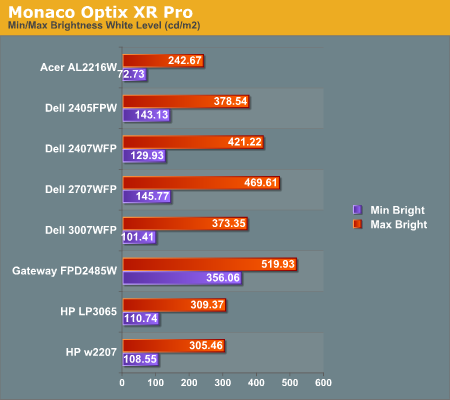
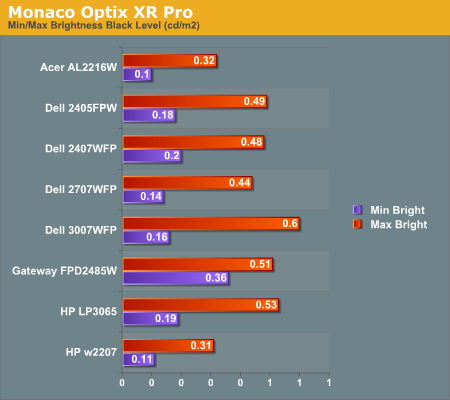
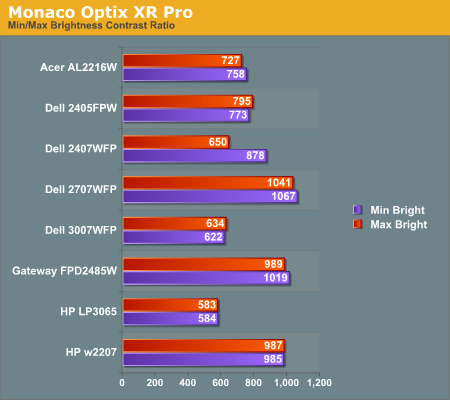
In the past we have seen LCDs that crank up the brightness level in order to increase the contrast ratio, but it's good to see that HP didn't go that route with the w2207. A maximum brightness level of 300 nits is pretty reasonable, and we don't see much reason to go beyond that. In practice, we tend to prefer a brightness level of around 200 nits, though others may prefer slightly brighter or darker. The HP w2207 can accommodate pretty much any desired brightness setting, and it does so while maintaining its exceptional ~1000:1 contrast ratio. That's one more item that sets it apart from the less-expensive Acer 22" LCD.
Color Accuracy
The problem with calibrating a display is that it doesn't help all applications. Specifically, the video overlay used when watching DVDs or other movies completely bypasses any color profiles, so you are stuck with the uncalibrated colors. Playing games and Windows Vista may also use the default color options - though in the case of the latter it's more a problem of determining how to set up your color profile properly. It is possible to tweak things somewhat on many LCDs using the OSD, but the amount of color correction that can be done via the OSD pales in comparison to color correction tables, and some LCDs (the Dell 3007WFP and HP LP3065 for example) are unable to adjust anything but brightness outside of software. Ideally, we would like to see video drivers begin to apply color profiles to all output - office applications, movies, games, or anything else.
For uncalibrated color accuracy, we adjusted the brightness as well as the contrast and colors (where applicable) using a "calibrate by eye" chart and the OSD controls. Also remember that color accuracy can vary from panel to panel even within the same model, and the results we are reporting are only from testing a single LCD. During testing, Monaco Optix XR Pro sends 24 color patches to the display with the colorimeter measuring the resulting values. The difference between what is requested and what the LCD actually shows is known as Delta E, with lower values being better. Any score less than one is basically "perfect" - the naked eye is not going to be able to tell the difference - and scores less than 2.0 are nearly perfect.
Ideally, you would want all of the tested colors to have a Delta E of less than 1.0, but almost no one is likely to have problems with anything scoring below 2.0. From 2.0 to 4.0, most people still won't notice the slight inaccuracies in the color palette, but when comparing displays side by side differences may be apparent - multimedia professionals in particular would prefer something better. Anything above 4.0 begins to represent a more significant deviance, and numerous scores above 6.0 will almost certainly be noticeable by just about anyone using the display. Consistency is also important, so a display that has very good scores overall but with high spikes on some colors may actually be less desirable than a display with a slightly higher but more consistent average Delta E. Note also that fluctuations of as much as one point in Delta E are possible during a short amount of time. It generally takes as much as 30 minutes for a display to warm up after it's first powered on, and all of our calibration and testing is performed after the displays have been running for at least one hour with the screensaver disabled.
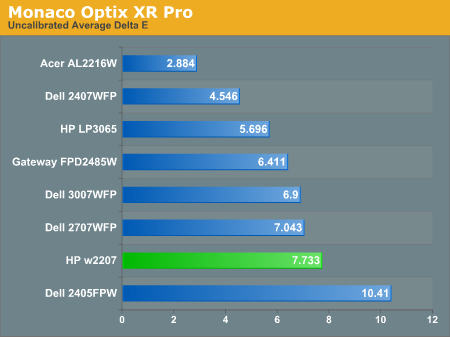
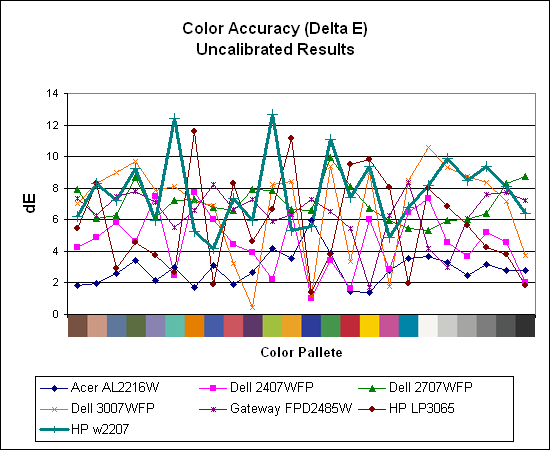
Without any form of color correction, the color accuracy of all of these displays is generally mediocre. The human eye will compensate quite a bit for differences between displays, so for most people even an average Delta E of 6.0 isn't going to be terrible. The HP w2207 rates a pretty poor 7.7 before calibration, besting only the two year old Dell 2405FPW. There are also quite a few spikes, with several colors having a Delta E of greater than 10.0. If you don't have color calibration equipment and you depend on accurate colors, the w2207 probably isn't the best choice. In fact, out of all of the LCDs we've tested so far, only the Acer AL2216W generates an uncalibrated Delta E result of less than 3.0. That particular display has other drawbacks, and we really wish that more of the displays could generate acceptable uncalibrated Delta E results.
For the brightness, contrast, and color accuracy tests we depend on the hardware colorimeter and software to help calibrate the displays. As previously stated, we use a Monaco Optix XR (DTP-94) colorimeter and Monaco Optix XR Pro software. The software and hardware help users to get more accurate color from their displays. Before we get to the calibrated results, we took a quick look at the range of brightness and contrast without any color calibration.



In the past we have seen LCDs that crank up the brightness level in order to increase the contrast ratio, but it's good to see that HP didn't go that route with the w2207. A maximum brightness level of 300 nits is pretty reasonable, and we don't see much reason to go beyond that. In practice, we tend to prefer a brightness level of around 200 nits, though others may prefer slightly brighter or darker. The HP w2207 can accommodate pretty much any desired brightness setting, and it does so while maintaining its exceptional ~1000:1 contrast ratio. That's one more item that sets it apart from the less-expensive Acer 22" LCD.
Color Accuracy
The problem with calibrating a display is that it doesn't help all applications. Specifically, the video overlay used when watching DVDs or other movies completely bypasses any color profiles, so you are stuck with the uncalibrated colors. Playing games and Windows Vista may also use the default color options - though in the case of the latter it's more a problem of determining how to set up your color profile properly. It is possible to tweak things somewhat on many LCDs using the OSD, but the amount of color correction that can be done via the OSD pales in comparison to color correction tables, and some LCDs (the Dell 3007WFP and HP LP3065 for example) are unable to adjust anything but brightness outside of software. Ideally, we would like to see video drivers begin to apply color profiles to all output - office applications, movies, games, or anything else.
For uncalibrated color accuracy, we adjusted the brightness as well as the contrast and colors (where applicable) using a "calibrate by eye" chart and the OSD controls. Also remember that color accuracy can vary from panel to panel even within the same model, and the results we are reporting are only from testing a single LCD. During testing, Monaco Optix XR Pro sends 24 color patches to the display with the colorimeter measuring the resulting values. The difference between what is requested and what the LCD actually shows is known as Delta E, with lower values being better. Any score less than one is basically "perfect" - the naked eye is not going to be able to tell the difference - and scores less than 2.0 are nearly perfect.
Ideally, you would want all of the tested colors to have a Delta E of less than 1.0, but almost no one is likely to have problems with anything scoring below 2.0. From 2.0 to 4.0, most people still won't notice the slight inaccuracies in the color palette, but when comparing displays side by side differences may be apparent - multimedia professionals in particular would prefer something better. Anything above 4.0 begins to represent a more significant deviance, and numerous scores above 6.0 will almost certainly be noticeable by just about anyone using the display. Consistency is also important, so a display that has very good scores overall but with high spikes on some colors may actually be less desirable than a display with a slightly higher but more consistent average Delta E. Note also that fluctuations of as much as one point in Delta E are possible during a short amount of time. It generally takes as much as 30 minutes for a display to warm up after it's first powered on, and all of our calibration and testing is performed after the displays have been running for at least one hour with the screensaver disabled.


Without any form of color correction, the color accuracy of all of these displays is generally mediocre. The human eye will compensate quite a bit for differences between displays, so for most people even an average Delta E of 6.0 isn't going to be terrible. The HP w2207 rates a pretty poor 7.7 before calibration, besting only the two year old Dell 2405FPW. There are also quite a few spikes, with several colors having a Delta E of greater than 10.0. If you don't have color calibration equipment and you depend on accurate colors, the w2207 probably isn't the best choice. In fact, out of all of the LCDs we've tested so far, only the Acer AL2216W generates an uncalibrated Delta E result of less than 3.0. That particular display has other drawbacks, and we really wish that more of the displays could generate acceptable uncalibrated Delta E results.










43 Comments
View All Comments
jc44 - Thursday, August 2, 2007 - link
Initially that would have been the approx asking price (medical applicatinos I think). They got cheaper as time went on though they were never exactly cheap. The Viewsonic (VP2290B) and Iiyama badged versions got under ~$7000 I think (which was approx twice the price on an Apple 30" at the time). Currently a DG5 (the last iteration) goes for ~$3500 on ebay and a VP2290B is ~$1000.The T221 was the first monitor that made me think "The best LCDs are btter than the best CRTs - now they only have to get cheap enough".
I was really hoping that they would take off and the price would come down to something like the current ebay prices. (And yes I did buy off ebay in the end)
Great Googly Moogly - Friday, August 3, 2007 - link
Aye, they're pretty damn cool. I've yet to see one in the flesh though. You still have to have 2 dual-link cards with it though? Doesn't it use 4 single-link connectors?And isn't the 48 Hz data rate (all 4 links) OK enough? (Yeah yeah, TFTs don't have refresh rates, I know, but there are other ramifications of a slow data rate.)
yacoub - Wednesday, August 1, 2007 - link
Not sure why 22" is starting to become prominent over 20". Must be cheaper to produce because tolerances and processes don't have to be as tight, since they're the same resolution just a larger (and thus more visible) pixel pitch on the 22" (0.282mm). Would rather stick with a 20", or if I want bigger then I'd get a 23-24" with 1920x resolution.Jedi2155 - Wednesday, August 1, 2007 - link
When comparing TN 20" versus a 22" panel with around $50 difference, i'd definitely go for the 22" mainly due to the larger screen space which makes games and movies more life-like.Sure the resolution hasn't changed, but why do people buy big screens with lower resolutions anyways? Just to get the bigger picture of course.
Oh, I also think there is a typo on Page 5 at the last paragraph.
You mentioned
But shouldn't it be
JarredWalton - Wednesday, August 1, 2007 - link
I corrected the Acer/Acer sentence -- HP seemed to be a bit better in the vertical plane. Things for the comment.nilepez - Wednesday, August 1, 2007 - link
I think the difference is that if you buy an 70" HDTV, you're not sitting as close as you are if you have a 42". Besides, a smaller TV with accurate colors trumps a big POS set with crap colors (and I've seen some awful HD monitors).
As a result, if the colors are better on the 20", I'd go with a 20".
JarredWalton - Wednesday, August 1, 2007 - link
I think a lot of the better 20" LCDs were IPS or PVA, which might account for the prices as well. Dell I'm pretty sure was IPS on the 2005FP (and FPW?). I think the cheaper 20" LCDs are now also using TN panels. Could be that they can only get the same amount of 22" or 20" panels out of a modern glass substrate, though... I haven't looked into it closely.Spoelie - Wednesday, August 1, 2007 - link
P-MVA and A-MVA are disregarded in the article, even though they are among the best 'overal' monitor technologies, for 20" at least. Second fastest response time, 8 bit color, best movie picture quality, homogeneous viewing angles. It's superior to PVA anyway.JarredWalton - Wednesday, August 1, 2007 - link
I thought MVA and PVA were similar and only certain patents created separate names. Guess not. :) I have never actually tested an MVA panel to my knowledge, and most high-end panels use IPS these days. The next tier uses PVA, and then the lower quality stuff uses TN. The one of the days, though, I will hopefully get the chance to test an MVA panel in person.mostlyprudent - Wednesday, August 1, 2007 - link
I have been using an HP LP series LCD which uses (at least when I bought it) an S-IPS panel. I could never go back to a TN or other panel with less acurate color display.